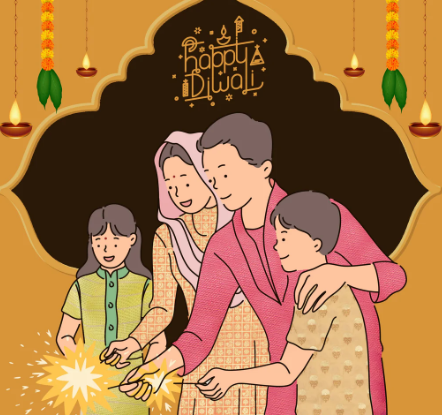Diwali, also known as the Festival of Lights, is one of the most celebrated festivals in India and among Indian communities worldwide. It usually takes place in October or November and lasts for five days. The festival symbolizes the victory of light over darkness and good over evil.
Each day of Diwali has its own significance:
- Dhanteras: Celebrating wealth and prosperity.
- Naraka Chaturdashi (Choti Diwali): Marking the defeat of the demon Narakasura.
- Diwali (Lakshmi Puja): Worshipping Goddess Lakshmi for wealth and prosperity.
- Govardhan Puja: Celebrating Lord Krishna’s lifting of the Govardhan Hill.
- Bhai Dooj: Honoring the bond between brothers and sisters.
It's a beautiful time for families and communities to come together, share joy, and spread kindness.
In Hindu tradition, Diwali commemorates the return of Lord Rama to Ayodhya after defeating the demon king Ravana, as depicted in the epic Ramayana. The people of Ayodhya lit lamps to celebrate his victory and homecoming.
In some regions, Diwali marks the day Lord Krishna defeated the demon Narakasura, freeing 16,100 captive princesses.
During Diwali, families often prepare these dishes together and share them with neighbors and friends, creating a sense of community and celebration. Various sweets like ladoos, gulab jamun, burfi and jalebis are prepared.
Rangoli is traditionally placed at the entrance of homes to welcome guests. The patterns and designs of rangoli are often created using natural colors, rice, or flour, representing purity and auspiciousness. It is believed to bring good luck and prosperity to the household. Many rangoli designs feature religious symbols, such as lotus flowers, peacocks, or geometric patterns, which are associated with various deities. This adds a spiritual dimension, as they are believed to attract positive energies. Rangoli is particularly significant as it marks the celebration of light and joy. The vibrant colors of rangoli contrast beautifully with the darkness of night, symbolizing the triumph of light over darkness.
Firecrackers are a popular part of Diwali celebrations, adding excitement and visual appeal to the festival. The vibrant colors and patterns created by fireworks add to the festive atmosphere, making Diwali nights particularly magical and memorable.Using firecrackers during Diwali has become a longstanding tradition in many regions. The sounds of bursting crackers are thought to ward off evil spirits and bring good fortune.
To conclude:
Diwali, the Festival of Lights, is a joyous celebration symbolizing the victory of light over darkness and good over evil. It brings families and communities together through traditions of lighting diyas, preparing delicious foods, creating vibrant rangoli, and enjoying fireworks. While steeped in rich cultural significance, it also encourages a spirit of generosity and gratitude, making it a cherished time for reflection and connection.
Thank you
Kyna Puri

